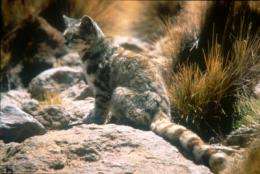Rare Andean cat no longer exclusive to the Andes

Once thought to exclusively inhabit its namesake mountain range, the threatened Andean cat—a house cat-sized feline that resembles a small snow leopard in both appearance and habitat—also frequents the Patagonian steppe at much lower elevations, according to a new study published by the Wildlife Conservation Society and partners.
The finding represents a range extension for the Andean cat, which normally occurs at altitudes above 3,000 meters (approximately 9,800 feet). The new survey presents evidence of the cats occurring at elevations as low as 650 meters (approximately 2,100 feet) on the Patagonian steppe. The species is listed as "Endangered" on the World Conservation Union's Red List and may number only 2,500 individuals throughout its entire range.
The study appears in the recent edition of CATNews. The authors include: Andres Novaro and Lorena Rivas of the Wildlife Conservation Society and CONICET, Argentina; Susan Walker of the Wildlife Conservation Society; Rocio Palacios of Alianza Gato Andino; Sebastian di Martino of Department of Protected Areas of the Province of Neuquén; Martin Monteverde of Centro de Ecología Aplicada del Neuquén; Sebastian Canadell of Universidad Nacional de Cordoba; and Daniel Cossios of Université de Montréal.
"These confirmed records show the lowest elevations ever reported for the Andean cat," said WCS conservationist Andres Novaro, lead author of the study. "According to genetic studies underway led by Daniel Cossios, this new population appears to represent an evolutionary lineage distinct from the highland population."
Prompted by a lone photograph of two Andean cats in the foothills of central Argentina, the research team surveyed approximately 31,000 square kilometers (approximately 12,000 square miles) of Argentina's Mendoza and Neuquén provinces in 2007-2009. The team collected samples from several locations that included scat, skulls, and skin, all of which were confirmed with DNA analysis. In addition, the researchers conducted surveys with inhabitants of the region. The conservationists also found evidence of three other small cat species: Geoffroy's cat, pampas cat, and jaguarundi.
The Andean cat's range extension coincides with the known distribution of the mountain vizcacha, a rabbit-like rodent that inhabits both the Andes Mountains and Patagonian steppe and is the Andean cat's primary prey.
"Discovering a new population of Andean cats is an important finding for this elusive and rare species," said Mariana Varese, Acting Director of WCS's Latin America and Caribbean Program. "Determining the range of the Andean cat in the Patagonian steppe will provide conservationists with a foundation for later conservation plans."
Threats to the newly discovered population of Andean cat include goat herders who assume the felines are preying on their livestock, oil exploration activities that destroy habitat, and new roads that open up formerly inaccessible areas to poachers.
Provided by Wildlife Conservation Society



















